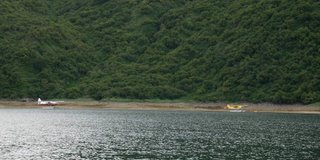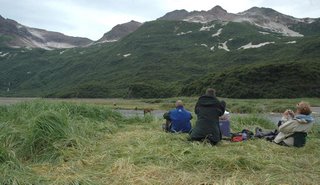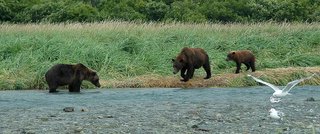20060824 Amalik Bay/Geographic Harbor Trip Part 4 The Assignment
20060824 Amalik Bay/Geographic Harbor Trip Part 4: The Assignment
This place is downright huge—Katmai National Park I mean. From 1931 until 1980 this was the largest single piece of property managed by the National Park Service. The coastline alone measures almost 500 miles.
Yellowstone does not compare sizewise to Katmai but receives 50-100 times the visitorship. Like most national parks, visitors concentrate in just a few areas within Katmai. Brooks Camp would be destination numero uno.
Beginning in 1950 Ray Peterson provided a lodge at Brooks to serve anglers who flew in to fish for Brooks River rainbow trout almost bigger than their imaginations. At the time lodge management and the anglers considered the bears a nuisance or worse.
Somewhere along the line the National Park Service decided that, though likely people had been doing it for 4,500 years, we would no longer remove the bears from the river corridor by hazing or worse. Somewhere along that same line, those with a profit motive realized that people would pay royally just for the opportunity to watch fishing at Brooks—not for trout but for salmon and not by people in chest waders but by bears in full-body fur coats.
Over the years the number of bears using the 1.5-mile Brooks River corridor has grown, as has the number of people coming to watch them. This presents park management with a nearly unsolvable problem. How do you provide perhaps 200 people per day with a satisfying bear viewing experience while keeping them relatively safe, keeping the bears relatively safe, and allowing the bears to behave as naturally as possible?
The current attempt at a solution includes restrictions governing food possession, consumption, storage, and transport. Backpacks and other gear must be attended or stored in designated areas. Visitors may not remain closer to a bear than 50 yards but otherwise are free to move about as they please with a few exceptions.
During periods of heavy bear use the ground around Brooks Falls is closed to entry; visitors, no more than 40 at a time, must remain on the elevated viewing platform overlooking the falls. To allow shy bears a chance to access the falls, the falls platforms closes from 10 pm to 7 am. Visitors may use without restriction a viewing platform downstream from the falls near the river mouth. Rangers regularly staff the platforms to facilitate the movement of people and bears. While this system is not without problems, it works pretty well.
Bears congregate at several other places in the park at different times, usually for salmon. On the Katmai Coast, bears gather at Hallo Bay in June to eat tender young sedges, a grass-like plant. Further south along the coast, at Geographic Harbor, in August bears attend the pink salmon run on Geographic Creek. By boat and plane, commercial operators have been bringing guests to these two locations for at least 15 years.
For the coastal areas like Hallo Bay and Geographic Harbor, the park doesn’t seem to have a system to manage the people and the bears. At Geographic Harbor the commercial operators have developed the system, a markedly different one from that at Brooks River.
Some operators, like cruise ships that anchor nearby from time to time, keep their clients in small boats as they watch bears. By not coming ashore they remain out of the Park’s jurisdiction.
By not coming ashore they remain out of the Park’s jurisdiction.  Others, mostly arriving in float planes, bring their clients ashore, always with a guide, to an island in the shallow braided creek near its mouth.
Others, mostly arriving in float planes, bring their clients ashore, always with a guide, to an island in the shallow braided creek near its mouth.  Rather than being free to move about as at Brooks, once on the island everyone sits and waits for the bears to move around them. If the bears choose to move in closer to people than 50 yards, which is inevitable in their quest for the salmon, so be it.
Rather than being free to move about as at Brooks, once on the island everyone sits and waits for the bears to move around them. If the bears choose to move in closer to people than 50 yards, which is inevitable in their quest for the salmon, so be it. 

Park managers want to take a long hard look at the coastal operations with an eye toward making long-term management decisions. As part of the process they would like feedback from visitors using that area. This is where Niki and I come in. We distributed mail-in surveys to visitors we contacted in Amalik Bay/Geographic Harbor.
If you want to watch bears go where the bears are, like Geographic Harbor in August. If you want to contact people watching bears go where they are, like the island in Geographic Creek. That is exactly what Niki and I did for six days.
 Al and Jason would ferry us twenty minutes by skiff from the ranger cabin to the creek, whereupon we joined a bear viewing group, usually 16 clients and a pilot/guide. We had been instructed not to interfere with the bear viewing experience so much of the 3½ hour bear viewing session we sat quietly watching bears fish and interact with one another.
Al and Jason would ferry us twenty minutes by skiff from the ranger cabin to the creek, whereupon we joined a bear viewing group, usually 16 clients and a pilot/guide. We had been instructed not to interfere with the bear viewing experience so much of the 3½ hour bear viewing session we sat quietly watching bears fish and interact with one another. 
 Occasionally we answered questions and made conversation. At a moment when no bears were present we would do our job of distributing surveys, one per traveling party, after providing the visitors with background information and collecting contact information from them.
Occasionally we answered questions and made conversation. At a moment when no bears were present we would do our job of distributing surveys, one per traveling party, after providing the visitors with background information and collecting contact information from them.
As you can tell, the work was grueling. It’s always tough to be paid to enjoy a once-in-a-lifetime experience for which visitors pay hundreds of dollars. Such is the life of a park ranger. Seriously though, the information gathering is vital to the management of a part of the park destined to become busier, a part of the park where a laissez-faire approach may one day be inappropriate.
This place is downright huge—Katmai National Park I mean. From 1931 until 1980 this was the largest single piece of property managed by the National Park Service. The coastline alone measures almost 500 miles.
Yellowstone does not compare sizewise to Katmai but receives 50-100 times the visitorship. Like most national parks, visitors concentrate in just a few areas within Katmai. Brooks Camp would be destination numero uno.
Beginning in 1950 Ray Peterson provided a lodge at Brooks to serve anglers who flew in to fish for Brooks River rainbow trout almost bigger than their imaginations. At the time lodge management and the anglers considered the bears a nuisance or worse.
Somewhere along the line the National Park Service decided that, though likely people had been doing it for 4,500 years, we would no longer remove the bears from the river corridor by hazing or worse. Somewhere along that same line, those with a profit motive realized that people would pay royally just for the opportunity to watch fishing at Brooks—not for trout but for salmon and not by people in chest waders but by bears in full-body fur coats.
Over the years the number of bears using the 1.5-mile Brooks River corridor has grown, as has the number of people coming to watch them. This presents park management with a nearly unsolvable problem. How do you provide perhaps 200 people per day with a satisfying bear viewing experience while keeping them relatively safe, keeping the bears relatively safe, and allowing the bears to behave as naturally as possible?
The current attempt at a solution includes restrictions governing food possession, consumption, storage, and transport. Backpacks and other gear must be attended or stored in designated areas. Visitors may not remain closer to a bear than 50 yards but otherwise are free to move about as they please with a few exceptions.
During periods of heavy bear use the ground around Brooks Falls is closed to entry; visitors, no more than 40 at a time, must remain on the elevated viewing platform overlooking the falls. To allow shy bears a chance to access the falls, the falls platforms closes from 10 pm to 7 am. Visitors may use without restriction a viewing platform downstream from the falls near the river mouth. Rangers regularly staff the platforms to facilitate the movement of people and bears. While this system is not without problems, it works pretty well.
Bears congregate at several other places in the park at different times, usually for salmon. On the Katmai Coast, bears gather at Hallo Bay in June to eat tender young sedges, a grass-like plant. Further south along the coast, at Geographic Harbor, in August bears attend the pink salmon run on Geographic Creek. By boat and plane, commercial operators have been bringing guests to these two locations for at least 15 years.
For the coastal areas like Hallo Bay and Geographic Harbor, the park doesn’t seem to have a system to manage the people and the bears. At Geographic Harbor the commercial operators have developed the system, a markedly different one from that at Brooks River.
Some operators, like cruise ships that anchor nearby from time to time, keep their clients in small boats as they watch bears.
 By not coming ashore they remain out of the Park’s jurisdiction.
By not coming ashore they remain out of the Park’s jurisdiction.  Others, mostly arriving in float planes, bring their clients ashore, always with a guide, to an island in the shallow braided creek near its mouth.
Others, mostly arriving in float planes, bring their clients ashore, always with a guide, to an island in the shallow braided creek near its mouth.  Rather than being free to move about as at Brooks, once on the island everyone sits and waits for the bears to move around them. If the bears choose to move in closer to people than 50 yards, which is inevitable in their quest for the salmon, so be it.
Rather than being free to move about as at Brooks, once on the island everyone sits and waits for the bears to move around them. If the bears choose to move in closer to people than 50 yards, which is inevitable in their quest for the salmon, so be it. 

Park managers want to take a long hard look at the coastal operations with an eye toward making long-term management decisions. As part of the process they would like feedback from visitors using that area. This is where Niki and I come in. We distributed mail-in surveys to visitors we contacted in Amalik Bay/Geographic Harbor.
If you want to watch bears go where the bears are, like Geographic Harbor in August. If you want to contact people watching bears go where they are, like the island in Geographic Creek. That is exactly what Niki and I did for six days.
 Al and Jason would ferry us twenty minutes by skiff from the ranger cabin to the creek, whereupon we joined a bear viewing group, usually 16 clients and a pilot/guide. We had been instructed not to interfere with the bear viewing experience so much of the 3½ hour bear viewing session we sat quietly watching bears fish and interact with one another.
Al and Jason would ferry us twenty minutes by skiff from the ranger cabin to the creek, whereupon we joined a bear viewing group, usually 16 clients and a pilot/guide. We had been instructed not to interfere with the bear viewing experience so much of the 3½ hour bear viewing session we sat quietly watching bears fish and interact with one another. 
 Occasionally we answered questions and made conversation. At a moment when no bears were present we would do our job of distributing surveys, one per traveling party, after providing the visitors with background information and collecting contact information from them.
Occasionally we answered questions and made conversation. At a moment when no bears were present we would do our job of distributing surveys, one per traveling party, after providing the visitors with background information and collecting contact information from them.As you can tell, the work was grueling. It’s always tough to be paid to enjoy a once-in-a-lifetime experience for which visitors pay hundreds of dollars. Such is the life of a park ranger. Seriously though, the information gathering is vital to the management of a part of the park destined to become busier, a part of the park where a laissez-faire approach may one day be inappropriate.
.jpg)

0 Comments:
Post a Comment
<< Home